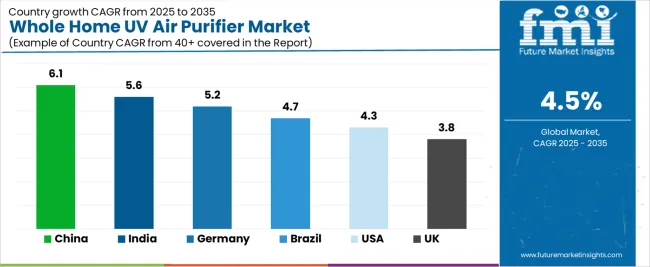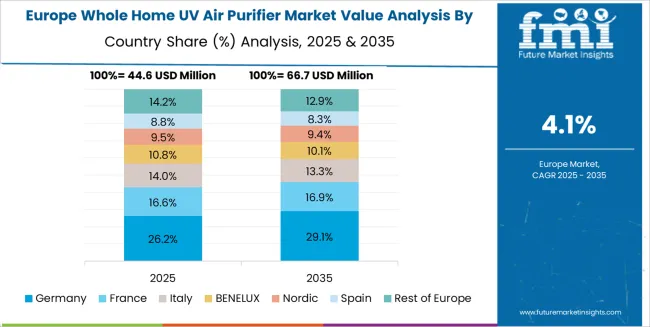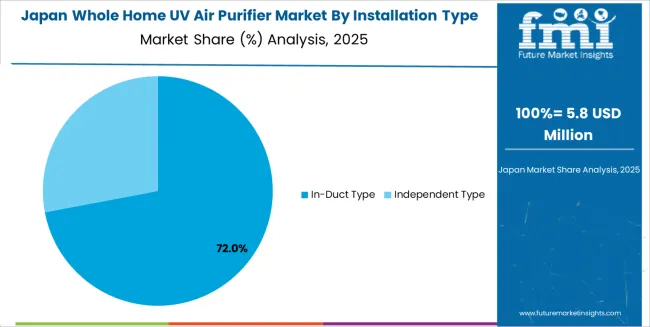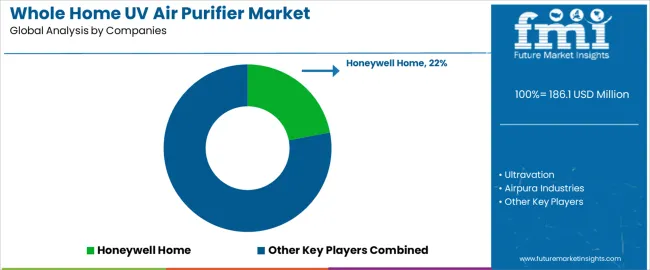The whole home UV air purifier market stands at the threshold of a decade-long expansion trajectory that promises to reshape indoor air quality technology and residential purification solutions. The market's journey from USD 186.1 million in 2025 to USD 289 million by 2035 represents substantial growth, demonstrating the accelerating adoption of advanced UV purification technology and precision air quality optimization across residential installations, commercial facilities, and healthcare sectors.
The first half of the decade (2025-2030) will witness the market climbing from USD 186.1 million to approximately USD 231.9 million, adding USD 45.8 million in value, which constitutes 45% of the total forecast growth period. This phase will be characterized by the rapid adoption of in-duct UV purification systems, driven by increasing air quality concerns and the growing need for advanced pathogen control solutions worldwide. Enhanced purification capabilities and automated monitoring systems will become standard expectations rather than premium options.
The latter half (2030-2035) will witness continued growth from USD 231.9 million to USD 289 million, representing an addition of USD 57.1 million or 55% of the decade's expansion. This period will be defined by mass market penetration of independent type technologies, integration with comprehensive HVAC management platforms, and seamless compatibility with existing residential infrastructure. The market trajectory signals fundamental shifts in how residential facilities approach air purification and indoor air quality management, with participants positioned to benefit from growing demand across multiple installation types and application segments.

| Period | Primary Revenue Buckets | Share | Notes |
|---|---|---|---|
| Today | New system sales (in-duct, independent units) | 43% | Installation-led, air quality-driven purchases |
| Replacement lamps & maintenance parts | 27% | UV bulb replacement, filter changes | |
| HVAC contractor installations | 19% | New construction, system upgrades | |
| Service & maintenance contracts | 11% | Annual servicing, performance verification | |
| Future (3-5 yrs) | Smart UV purification systems | 36-40% | IoT connectivity, air quality monitoring integration |
| Integrated HVAC solutions | 24-28% | Whole-home air quality packages, system coordination | |
| Replacement lamps & consumables | 16-20% | UV bulb lifecycle management, filter subscriptions | |
| Retrofit installations | 12-15% | Existing HVAC upgrades, air quality improvements | |
| Monitoring & analytics services | 8-11% | Real-time air quality tracking, remote diagnostics | |
| Professional services (installation, commissioning, testing) | 5-8% | Value-added technical support |
| Metric | Value |
|---|---|
| Market Value (2025) | USD 186.1 million |
| Market Forecast (2035) | USD 289 million |
| Growth Rate | 4.5% CAGR |
| Leading Technology | In-Duct Type |
| Primary Application | Home Use Segment |
The market demonstrates strong fundamentals with in-duct installation systems capturing a dominant share through advanced UV purification capabilities and residential air quality optimization. Home use applications drive primary demand, supported by increasing health awareness and indoor air quality concerns. Geographic expansion remains concentrated in developed markets with established HVAC infrastructure, while emerging economies show accelerating adoption rates driven by air quality initiatives and rising health consciousness standards.
Primary Classification: The market segments by installation type into in-duct type and independent type categories, representing the evolution from basic purification equipment to sophisticated air quality solutions for comprehensive residential and commercial air quality optimization.
Secondary Classification: Application segmentation divides the market into home use, commercial use, hospital use, and others, reflecting distinct requirements for air purification, pathogen control, and installation compatibility standards.
Regional Classification: Geographic distribution covers North America, Latin America, Western Europe, Eastern Europe, East Asia, South Asia Pacific, and Middle East & Africa, with developed markets leading adoption while emerging economies show accelerating growth patterns driven by air quality awareness programs.
The segmentation structure reveals technology progression from standard purification equipment toward sophisticated UV systems with enhanced pathogen elimination and monitoring capabilities, while application diversity spans from residential installations to healthcare facilities requiring comprehensive air quality control solutions.

Market Position: In-Duct Type systems command the leading position in the whole home UV air purifier market with 69.2% market share through advanced purification features, including superior pathogen elimination, whole-home coverage, and residential air quality optimization that enable HVAC systems to achieve optimal air purification across diverse residential and commercial environments.
Value Drivers: The segment benefits from residential and commercial preference for integrated purification systems that provide continuous air treatment, HVAC compatibility, and air quality optimization without requiring significant space allocation. Advanced design features enable seamless HVAC integration, UV intensity control, and compatibility with existing ductwork systems, where operational performance and installation efficiency represent critical facility requirements.
Competitive Advantages: In-Duct Type systems differentiate through proven HVAC integration, comprehensive air treatment characteristics, and compatibility with standard heating and cooling systems that enhance facility air quality while maintaining optimal purification standards suitable for diverse residential and commercial applications.
Key market characteristics:
Independent Type systems maintain a 30.8% market position in the whole home UV air purifier market due to their installation flexibility properties and standalone application advantages. These systems appeal to facilities requiring portable purification solutions with competitive pricing for room-specific or commercial applications. Market growth is driven by commercial expansion, emphasizing flexible purification solutions and operational efficiency through optimized unit designs.

Market Context: Home use applications demonstrate the highest growth rate in the whole home UV air purifier market with 6.1% CAGR due to widespread adoption of residential air quality systems and increasing focus on health protection optimization, pathogen control improvement, and indoor environment applications that maximize air quality while maintaining comfort standards.
Appeal Factors: Home use facility operators prioritize system effectiveness, energy efficiency, and integration with existing HVAC infrastructure that enables coordinated air purification across entire residences. The segment benefits from substantial residential investment and HVAC modernization programs that emphasize the acquisition of UV purification systems for health protection and air quality improvement applications.
Growth Drivers: Residential health awareness programs incorporate UV air purifiers as essential components for indoor air quality operations, while HVAC modernization increases demand for integrated purification capabilities that comply with health standards and minimize pathogen exposure risk.
Market Challenges: Varying HVAC configurations and installation complexity may limit system standardization across different homes or installation scenarios.
Application dynamics include:
Commercial Use applications capture market share through essential purification requirements in office buildings, retail facilities, and commercial spaces. These facilities demand reliable UV systems capable of operating with high air circulation while providing effective pathogen control and air quality management capabilities.
Hospital Use applications account for market share, including healthcare facilities, medical clinics, and patient care environments requiring specialized air purification capabilities for infection control and patient safety optimization.
Market Position: East Asia commands significant market position with 6.1% CAGR through rapid urbanization that drives demand for air quality solutions across residential and commercial facilities.
Value Drivers: This region provides the ideal combination of air quality concerns and health awareness growth, meeting requirements for residential applications, commercial installations, and healthcare facility projects without excessive technology complexity.
Growth Characteristics: The segment benefits from broad air quality initiatives across building sectors, government health programs, and established HVAC infrastructure that supports widespread adoption and operational efficiency.
| Category | Factor | Impact | Why It Matters |
|---|---|---|---|
| Driver | Health awareness & pathogen concerns (pandemic impact, airborne disease prevention) | ★★★★★ | Increased focus on indoor air quality drives demand for effective purification solutions with proven pathogen elimination and continuous air treatment. |
| Driver | HVAC system modernization & energy efficiency programs | ★★★★★ | New construction and system upgrades create installation opportunities; integrated UV solutions gain traction in comprehensive air quality packages. |
| Driver | Air quality regulations & building standards (indoor air quality codes) | ★★★★☆ | Building code requirements increasingly address air quality; UV purification adoption expanding in commercial and institutional construction. |
| Restraint | High initial cost & installation complexity (especially retrofit applications) | ★★★★☆ | UV system costs deter budget-conscious homeowners; professional installation requirements increase total ownership costs. |
| Restraint | Maintenance requirements & lamp replacement costs | ★★★☆☆ | Regular UV bulb replacement creates ongoing expense; maintenance complexity limits adoption in price-sensitive residential segments. |
| Trend | Smart integration & air quality monitoring | ★★★★★ | IoT connectivity enables real-time monitoring and remote control; digital features transform UV purifiers into comprehensive air quality management systems. |
| Trend | Whole-home air quality solutions & multi-technology approaches | ★★★★☆ | Integrated systems combining UV, filtration, and humidity control; comprehensive solutions drive premium segment growth and contractor partnerships. |
The whole home UV air purifier market demonstrates varied regional dynamics with Growth Leaders including China (6.1% growth rate) and India (5.6% growth rate) driving expansion through air quality initiatives and residential construction development. Steady Performers encompass Germany (5.2% growth rate), Brazil (4.7% growth rate), and developed regions, benefiting from established HVAC markets and health awareness adoption. Emerging Markets feature developing regions, where air quality concerns and building modernization support consistent growth patterns.
Regional synthesis reveals East Asian markets leading adoption through urbanization expansion and air quality initiatives, while South Asian countries maintain strong growth supported by residential construction and health awareness advancement. European and North American markets show moderate growth driven by HVAC replacement and air quality upgrade trends.

| Region/Country | 2025-2035 Growth | How to win | What to watch out |
|---|---|---|---|
| China | 6.1% | Lead with integrated HVAC solutions | Air quality device saturation; competition intensity |
| India | 5.6% | Focus on health benefits messaging | Price sensitivity; HVAC penetration rates |
| Germany | 5.2% | Offer premium efficiency systems | Regulatory complexity; certification requirements |
| Brazil | 4.7% | Value-oriented product mix | Economic uncertainty; installation infrastructure |
| United States | 4.3% | Provide contractor partnerships | Market fragmentation; DIY competition |
| United Kingdom | 3.8% | Push smart home integration | Market maturity; heating-focused HVAC systems |

China establishes fastest market growth through aggressive air quality programs and comprehensive residential construction development, integrating whole home UV air purifiers as essential components in HVAC installations and air quality improvement applications. The country's 6.1% growth rate reflects government initiatives promoting indoor air quality and domestic HVAC manufacturing capabilities that encourage the use of advanced purification systems in residential and commercial facilities. Growth concentrates in major urban centers, including Beijing, Shanghai, and Guangzhou, where air quality technology development showcases integrated UV systems that appeal to homeowners seeking advanced health protection capabilities and air quality optimization applications.
Chinese manufacturers are developing cost-effective UV purification solutions that combine domestic production advantages with performance features, including high-intensity UV output and smart monitoring capabilities. Distribution channels through HVAC equipment suppliers and home improvement distributors expand market access, while government support for air quality standards supports adoption across diverse residential and commercial segments.
Strategic Market Indicators:
In Delhi, Mumbai, and Bangalore, residential buildings and commercial facilities are implementing whole home UV air purifiers as essential equipment for air quality improvement and health protection applications, driven by increasing air pollution concerns and residential construction programs that emphasize the importance of indoor air quality capabilities. The market holds a 5.6% growth rate, supported by growing health awareness initiatives and HVAC adoption programs that promote UV purification systems for residential and commercial facilities. Indian operators are adopting purification systems that provide effective pathogen control and cost-efficient features, particularly appealing in regions where air quality concerns and health protection represent critical installation requirements.
Market expansion benefits from growing HVAC penetration capabilities and international technology partnerships that enable domestic availability of UV purification systems for residential and commercial applications. Technology adoption follows patterns established in air quality equipment, where effectiveness and value drive procurement decisions and installation deployment.
Market Intelligence Brief:
Germany establishes technology leadership through comprehensive indoor air quality programs and advanced HVAC infrastructure development, integrating whole home UV air purifiers across residential and commercial applications. The country's 5.2% growth rate reflects established HVAC industry relationships and mature air purification technology adoption that supports widespread use of premium UV systems in residential and commercial facilities. Growth concentrates in major urban centers, including Berlin, Munich, and Hamburg, where HVAC technology showcases mature UV purification deployment that appeals to homeowners seeking proven air quality capabilities and health protection applications.
German equipment providers leverage established distribution networks and comprehensive technical capabilities, including installation support and performance verification that create customer relationships and operational advantages. The market benefits from mature building standards and air quality requirements that support UV purification system use while encouraging technology advancement and efficacy optimization.
Market Intelligence Brief:
Brazil's market expansion benefits from diverse air quality demand, including residential construction in São Paulo and Rio de Janeiro, commercial facility development, and growing health awareness programs that increasingly incorporate UV purification solutions for indoor air quality applications. The country maintains a 4.7% growth rate, driven by rising HVAC adoption activity and increasing recognition of air purification benefits, including pathogen control and respiratory health protection.
Market dynamics focus on cost-effective UV purification solutions that balance operational performance with affordability considerations important to Brazilian homeowners and commercial operators. Growing urban development creates continued demand for modern air quality systems in new residential infrastructure and HVAC modernization projects.
Strategic Market Considerations:
United States establishes market position through comprehensive indoor air quality programs and mature HVAC infrastructure development, integrating whole home UV air purifiers across residential and commercial applications. The country's 4.3% growth rate reflects established HVAC industry relationships and mature technology adoption that supports widespread use of UV purification systems in residential and commercial facilities. Growth concentrates in major metropolitan regions, including California, Texas, and Florida, where air quality concerns maintain steady UV purifier demand that appeals to homeowners seeking proven pathogen control capabilities and health protection applications.
American HVAC contractors leverage established service networks and comprehensive installation capabilities, including technical support and maintenance services that create customer advantages. The market benefits from mature building code requirements and air quality awareness that support UV purification system demand while encouraging performance improvements.
Market Intelligence Brief:
United Kingdom's market demonstrates mature air quality deployment with operational effectiveness in residential applications and commercial facilities through integration with existing HVAC systems and building infrastructure. The country maintains a 3.8% growth rate through system replacement demand and air quality upgrade programs. Urban regions, including London, Manchester, and Birmingham, showcase established installations where UV purification systems integrate with heating systems and building ventilation programs to optimize indoor air quality.
British distributors prioritize product availability and technical support in UV purifier supply operations, creating demand for reliable systems with proven performance, including installation guidance and maintenance support. The market benefits from established building regulations and a focus on indoor air quality that provides steady installation demand and compliance with health standards.
Market Intelligence Brief:

The whole home UV air purifier market in Europe is projected to grow from USD 69.2 million in 2025 to USD 107.6 million by 2035, registering a CAGR of 4.5% over the forecast period. Germany is expected to maintain its leadership position with a 33.4% market share in 2025, supported by its advanced HVAC infrastructure and major urban centers including Berlin and Munich.
United Kingdom follows with a 21.7% share in 2025, driven by comprehensive indoor air quality programs and HVAC modernization initiatives. France holds a 17.9% share through specialized residential applications and building air quality requirements. Italy commands a 13.8% share, while Spain accounts for 9.1% in 2025. The rest of Europe region is anticipated to gain momentum, expanding its collective share from 4.1% to 4.9% by 2035, attributed to increasing UV purification adoption in Nordic countries and emerging Eastern European residential buildings implementing air quality improvement programs.

Japan's market exhibits sophisticated air purification integration with documented operational effectiveness in residential buildings and commercial applications through compatibility with existing HVAC systems and building infrastructure. The country maintains a 3.4% growth rate, leveraging engineering expertise in air quality technology and health protection. Urban centers showcase premium installations where UV purification systems integrate with comprehensive building management platforms and environmental monitoring systems to optimize indoor air quality and occupant health.
Japanese manufacturers prioritize system quality and health efficacy in UV purifier development, creating demand for premium products with advanced features, including smart monitoring integration and automated lamp replacement alerts. The market benefits from established HVAC infrastructure and investment in residential health that provides long-term operational benefits and compliance with air quality standards.

South Korea maintains a 3.2% growth rate through advanced building programs and air quality technology development initiatives that integrate UV purification systems across residential complexes, commercial buildings, and healthcare applications. The country's residential facilities implement UV purification solutions for pathogen control operations and indoor air quality management, with technology adoption driven by health awareness and smart home integration programs. Market development focuses on high-performance UV systems with enhanced monitoring capabilities and IoT connectivity features for residential applications.
The whole home UV air purifier market operates with a moderately consolidated structure where 18-25 established players maintain significant presence, with the top 6-9 manufacturers holding approximately 45-52% market share by revenue. Market leadership is maintained through HVAC contractor relationships, distribution network strength, technical support capabilities, and product efficacy validation that enables reliable pathogen control while maintaining competitive pricing across application segments.
Basic UV purification functionality is becoming increasingly standardized, with entry-level whole home systems offering similar pathogen reduction characteristics across manufacturers. Margin opportunities exist in value-added features including smart monitoring capabilities, automated lamp replacement alerts, comprehensive installation support services, and integrated air quality analytics that extend beyond standard equipment supply.
Major HVAC manufacturers compete through comprehensive system integration and established contractor networks, while specialized air purification companies leverage technical expertise and efficacy validation capabilities. The competitive environment increasingly emphasizes HVAC compatibility, installation simplicity, and total air quality system coordination rather than purely UV device-based differentiation. HVAC contractor partnerships represent a critical competitive advantage, with established relationships creating barriers to entry for new participants without contractor channel access.
Technology innovation focuses on higher UV intensity outputs, optimized air exposure design, smart home integration capabilities, and multi-stage purification approaches. Fundamental UV-C germicidal technology remains relatively stable, with competitive differentiation emerging through installation design optimization, HVAC compatibility breadth, and customer support capabilities. The market experiences moderate pricing pressure from direct-to-consumer brands, particularly in independent unit segments, while in-duct professional installation categories maintain value through proven efficacy and comprehensive contractor support services.
| Stakeholder | What they actually control | Typical strengths | Typical blind spots |
|---|---|---|---|
| HVAC manufacturers | Equipment integration, contractor networks, brand trust | Complete system solutions, professional installation, warranty integration | Innovation speed; air quality specialization depth |
| Air purification specialists | UV technology expertise, efficacy validation, health messaging | Pathogen control focus, technical performance, application engineering | HVAC channel access; broad distribution reach |
| HVAC contractors | Installation control, customer relationships, service access | Local presence, maintenance capability, system knowledge | Product differentiation understanding; technology expertise |
| Direct-to-consumer brands | Online channels, consumer marketing, price positioning | Digital engagement, brand building, affordability | Professional installation support; contractor relationships |

| Item | Value |
|---|---|
| Quantitative Units | USD 186.1 million |
| Installation Type | In-Duct Type, Independent Type |
| Application | Home Use, Commercial Use, Hospital Use, Others |
| Regions Covered | North America, Latin America, Western Europe, Eastern Europe, East Asia, South Asia Pacific, Middle East & Africa |
| Countries Covered | United States, China, Germany, India, United Kingdom, Japan, Brazil, and 20+ additional countries |
| Key Companies Profiled | Ultravation, Airpura Industries, Allerair, Amaircare, Bryant, Carrier, Daikin Air Purifiers, Fresh-Aire UV, TRACS Air Purifiers, Honeywell Home, Johnson Controls, Lennox, LUMINOR, Purahome, Sanuvox |
| Additional Attributes | Dollar sales by installation type and application categories, regional adoption trends across East Asia, South Asia Pacific, and Western Europe, competitive landscape with HVAC equipment manufacturers and air purification specialists, homeowner and facility operator preferences for air quality control reliability and system effectiveness, integration with HVAC systems and building management platforms, innovations in UV purification technology and efficacy enhancement, and development of advanced air quality solutions with enhanced pathogen control and residential optimization capabilities. |
The global whole home uv air purifier market is estimated to be valued at USD 186.1 million in 2025.
The market size for the whole home uv air purifier market is projected to reach USD 289.0 million by 2035.
The whole home uv air purifier market is expected to grow at a 4.5% CAGR between 2025 and 2035.
The key product types in whole home uv air purifier market are in-duct type and independent type.
In terms of application, home use segment to command 50.0% share in the whole home uv air purifier market in 2025.






Full Research Suite comprises of:
Market outlook & trends analysis
Interviews & case studies
Strategic recommendations
Vendor profiles & capabilities analysis
5-year forecasts
8 regions and 60+ country-level data splits
Market segment data splits
12 months of continuous data updates
DELIVERED AS:
PDF EXCEL ONLINE
Whole Genome Amplification Market Size and Share Forecast Outlook 2025 to 2035
Whole-Body Imaging Market Size and Share Forecast Outlook 2025 to 2035
Whole-Wheat Flour Market Size, Growth, and Forecast 2025 to 2035
Whole Grain & High Fiber Foods Market Growth – Demand, Trends & Forecast 2025–2035
Whole Grain Salty Snacks Market Analysis by Product Type, Product Claim, Source, Distribution Channel and Region Through 2035
Whole Plasmid Sequencing Market Growth – Innovations, Trends & Forecast 2025-2035
Whole Milk Powder Market
Wholesale Roaming Market Insights – Growth & Forecast 2023-2033
Whole Home In-Duct Air Purifier Market Size and Share Forecast Outlook 2025 to 2035
United Kingdom Whole Grain and High Fiber Foods Market Report – Trends & Forecast 2025–2035
Dry Whole Milk Powder Market Size and Share Forecast Outlook 2025 to 2035
United States Whole Grain and High Fiber Foods Market Report – Trends & Forecast 2025–2035
Japan Whole-wheat Flour Market Analysis by Product Type, Nature, Application, Packaging, Sales Channel, and Region Through 2035
Korea Whole-wheat Flour Market Analysis by Product Type, Nature, Application, Packaging, Sales Channel, and Region Through 2035
Europe Whole Grain and High Fiber Foods Market Insights – Size & Forecast 2025–2035
Demand for Whole-Wheat Flour in EU Size and Share Forecast Outlook 2025 to 2035
Asia Pacific Whole Grain and High Fiber Foods Market Outlook – Size, Share & Forecast 2025–2035
International Wholesale Voice Carrier Market Size and Share Forecast Outlook 2025 to 2035
Western Europe Whole Wheat Flour Market Analysis – Trends, Demand & Forecast 2025–2035
Home Sleep Screening Device Market Size and Share Forecast Outlook 2025 to 2035

Thank you!
You will receive an email from our Business Development Manager. Please be sure to check your SPAM/JUNK folder too.
Chat With
MaRIA